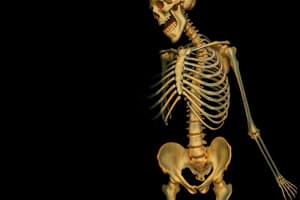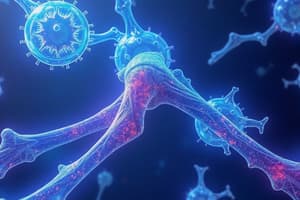Podcast
Questions and Answers
What type of bone is characterized by its long, cylindrical shape and is primarily found in the arms and legs?
What type of bone is characterized by its long, cylindrical shape and is primarily found in the arms and legs?
- Irregular bone
- Long bone (correct)
- Short bone
- Flat bone
Which of the following is NOT a function of bone tissue?
Which of the following is NOT a function of bone tissue?
- Blood cell formation
- Mineral storage
- Production of hormones (correct)
- Support
Which type of ossification occurs when bone forms directly in the matrix by increasing collagenous fibers?
Which type of ossification occurs when bone forms directly in the matrix by increasing collagenous fibers?
- Paraossification
- Endochondral ossification
- Perichondral ossification
- Intramembranous ossification (correct)
What is the structural unit of compact bone called?
What is the structural unit of compact bone called?
Which component of a bone provides a surface for the attachment of tendons and ligaments?
Which component of a bone provides a surface for the attachment of tendons and ligaments?
Which statement about spongy bone tissue is correct?
Which statement about spongy bone tissue is correct?
Where does the nutrient artery typically enter a long bone?
Where does the nutrient artery typically enter a long bone?
Which part of the bone is responsible for the production of red blood cells?
Which part of the bone is responsible for the production of red blood cells?
Which of the following best describes the function of canaliculi in compact bone?
Which of the following best describes the function of canaliculi in compact bone?
What is the first step in endochondral ossification?
What is the first step in endochondral ossification?
Which zone of the epiphyseal plate contains dead chondrocytes due to calcification?
Which zone of the epiphyseal plate contains dead chondrocytes due to calcification?
What characterizes synovial joints?
What characterizes synovial joints?
Which type of fracture is characterized by the bone being broken into several pieces?
Which type of fracture is characterized by the bone being broken into several pieces?
What primarily determines the final shape of a bone during modeling?
What primarily determines the final shape of a bone during modeling?
Which characteristic is true for amphiarthrosis joints?
Which characteristic is true for amphiarthrosis joints?
What is not a component of a lever system in human movement?
What is not a component of a lever system in human movement?
Which type of fracture is commonly associated with the wrist, particularly after a fall?
Which type of fracture is commonly associated with the wrist, particularly after a fall?
Flashcards
Osteology
Osteology
The study of bones. Arthrology is the study of joints.
Functions of Bone
Functions of Bone
Provides support, protection, movement, mineral storage, blood cell production, and triglyceride storage.
Endochondral Ossification
Endochondral Ossification
Bone forms by replacing hyaline cartilage.
Intramembranous Ossification
Intramembranous Ossification
Signup and view all the flashcards
Diaphysis
Diaphysis
Signup and view all the flashcards
Epiphyses
Epiphyses
Signup and view all the flashcards
Compact Bone
Compact Bone
Signup and view all the flashcards
Spongy Bone
Spongy Bone
Signup and view all the flashcards
Periosteal Arteries
Periosteal Arteries
Signup and view all the flashcards
Nutrient Artery
Nutrient Artery
Signup and view all the flashcards
Growth in Length
Growth in Length
Signup and view all the flashcards
Growth in Thickness
Growth in Thickness
Signup and view all the flashcards
Open Fracture
Open Fracture
Signup and view all the flashcards
Synarthrosis
Synarthrosis
Signup and view all the flashcards
Amphiarthrosis
Amphiarthrosis
Signup and view all the flashcards
Diarthrosis
Diarthrosis
Signup and view all the flashcards
Synovial Joints
Synovial Joints
Signup and view all the flashcards
Study Notes
General Osteology
- Osteology is the study of bones; arthrology focuses on joints.
- Human skeleton is an endoskeleton; insects possess an exoskeleton.
- Bone classes include long, short, flat, and irregular bones.
Functions of Bone
- Provides structural support for the body.
- Protects vital organs from injury.
- Acts as levers for muscle movement.
- Stores and releases essential minerals.
- Facilitates blood cell formation in bone marrow.
- Stores triglycerides in yellow bone marrow.
Types of Ossification
- Endochondral ossification involves the replacement of hyaline cartilage to form long bones.
- Intramembranous ossification occurs in flat bones, forming directly in the matrix.
Bone Tissue Characteristics
- Complex, dynamic living tissue that continuously remodels.
- Composed of osseous, cartilage, dense connective tissue, epithelium, adipose, and nervous tissue.
- Basic functions include support, protection, movement assistance, mineral storage, blood cell production, and triglyceride storage.
General Features of Bone
- Diaphysis is the long central shaft of a bone.
- Epiphyses are the ends of long bones.
- Metaphyses include the epiphyseal plate for growth.
- Articular cartilage covers bone ends for joint protection.
- Periosteum is a fibrous membrane that covers each bone, excluding articular surfaces.
- Medullary cavity contains yellow bone marrow; endosteum lines the cavity.
Compact Bone
- Dense and solid in appearance, but microscopically porous.
- Primarily found in the diaphysis of long bones, providing strength and resistance to stress.
- Composed of osteons (Haversian systems) which include the osteonic canal, concentric lamellae, lacunae, and canaliculi.
Spongy Bone Tissue
- Also known as trabecular or cancellous bone; lacks osteons.
- Found within the bones, covered by compact bone.
- Comprised of trabeculae arranged in thin columns, with spaces filled by red or yellow bone marrow.
Blood Supply to Bone
- Periosteal arteries supply the periosteum and outer compact bone.
- Nutrient artery enters diaphysis, with a path away from the growth end of the bone.
- Metaphyseal and epiphyseal arteries support growth at joints.
Bone Formation Stages
- Initial bone formation occurs in the embryo and fetus.
- General growth continues during infancy, childhood, and early adulthood.
- Remodeling happens throughout life, including fracture repair.
Growth in Length
- Epiphyseal plate has zones of reserve, proliferating, hypertrophic cartilage, and calcified cartilage essential for growth.
- Osteoclasts dissolve calcified cartilage, while osteoblasts generate bone matrix.
Bone Growth in Thickness
- Bone modeling influenced by gravitational forces (pressure epiphyses) and functional forces (traction epiphyses).
Fractures
- Open (compound), comminuted, greenstick, impacted, Pott, Colles fractures are types of bone injuries varying in severity.
Joint Classification
- Synarthrosis (immovable): Includes sutures, syndesmosis, gomphosis.
- Amphiarthrosis (slightly movable): Includes symphysis and synchondrosis.
- Diarthrosis (freely movable): Includes various types of synovial joints.
Synovial Joint Characteristics
- Comprise a joint capsule, articulating surfaces, articular cartilage, synovial membrane, and synovial fluid.
Lever Systems in Human Movement
- Long bones act as levers; joints function as fulcrums, with muscles providing the force for movement against resistance.
Studying That Suits You
Use AI to generate personalized quizzes and flashcards to suit your learning preferences.



